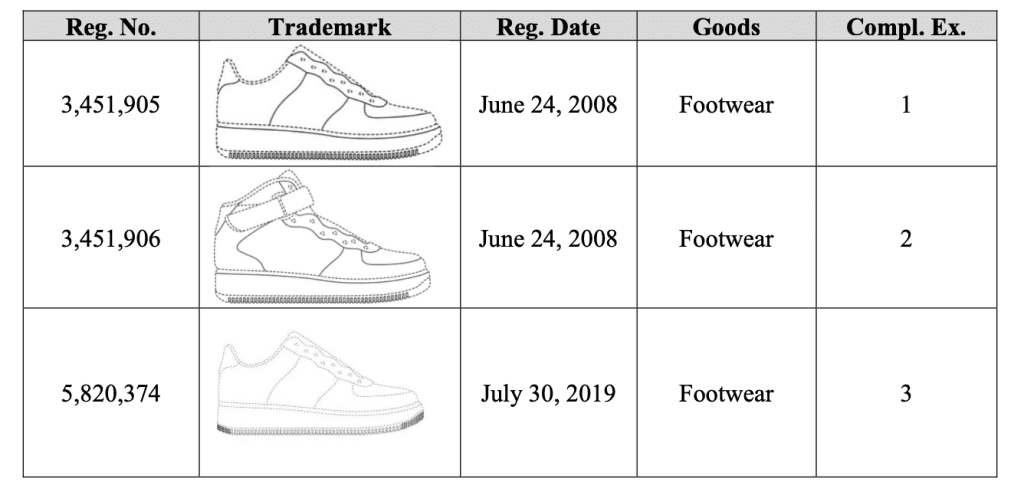Bape is pushing back against the trademark lawsuit waged against it by Nike, asserting in a letter to Judge Paul Gardephe of the U.S. District Court for the Southern District of New York that Nike has failed to identify its purported trade dress with the requisite particularity, and as a result, its complaint must be dismissed in its entirety. Setting the stage in the Feb. 17 letter, counsel for Bape (Cowan’s Kieran Doyle) states that the parties’ dispute goes back almost fourteen years when Nike’s in-house counsel “object[ed] to BAPE’s sneaker designs as purportedly infringing Nike’s trade dress.” Since then, BAPE asserts that Nike has “repeatedly failed to identify in detail the nature of its alleged rights in the overall look of its sneakers.”
Specifically, BAPE claims that in October 2009, four years after it began selling the sneaker designs at issue, including the BAPESTA sneaker, Nike presented it with a proposed agreement that would require it to license the underlying trade dress from Nike or to stop selling the BAPESTA sneakers, which BAPE says that it rejected. “Despite being confronted with BAPE’s assessment that Nike had no ‘viable or actionable claims’ and despite being invited to ‘spell out what claims Nike believe[d] that it could advance,’” BAPE claims that Nike “failed to provide the specifics of its trade dress claims and dropped the matter.” Preliminarily raising its inevitable laches defense, the company alleges that it did not hear from Nike again regarding the BAPESTA sneakers until 2021 when Nike sent it the demand letter that preceded this lawsuit.

The problem, according to BAPE, is that Nike’s cease-and-desist – and its subsequent complaint – “fail to identify the elements that make up Nike’s purported trade dress,” thereby, warranting a dismissal, as “a party alleging a violation of its trade dress must specifically identify its trade dress to sustain its claim.” Citing various SDNY and Second Circuit decisions that center on trade dress pleadings, BAPE contends that Nike’s allegations “fall short of what is required for a cognizable trade dress claim,” as the sportswear giant merely includes “the registration numbers associated with the asserted marks” (namely, its Air Force 1, Dunk, or Air Jordan trade dress), “the drawings attached to the asserted registrations, and photographs of certain shoes bearing the asserted marks.”
This approach is inadequate, per BAPE, which states that “courts encountering pleadings such as these have repeatedly held that a party cannot simply point to its registrations but must identify the features of its trade dress with specificity … because ‘[a] registration is prima facie evidence of the validity of the registered mark, not the clarity of its scope.’”
Looking to get ahead of a potential effort by Nike to “cure this deficiency,” BAPE argues that Nike cannot “simply import the descriptions of its trade dress from the asserted registrations into an amended complaint” to sidestep BAPE’s claim, as those descriptions are “also impermissibly vague.” For example, BAPE highlights the trade dress description in one Nike’s registrations for its Air Force 1 (Reg. No. 3,451,905), which it says “identifies parts of a shoe but does not describe what is distinctive about each of those parts.” This is “precisely the sort of ‘laundry list of the elements that constitute a … design, rather than a description of which of the plaintiff’s trade dress design elements are distinctive and how they are distinctive’ that the court rejected in Nat’l Lighting Co.” Nike’s “list of shoe parts fails for the same reason National Lighting’s list of light fixture parts failed,” per BAPE.
Because Nike “has failed to allege any elements of its asserted marks, let alone a description of how those elements are distinctive, the Court should dismiss the complaint,” BAPE argues, and “to extent that such dismissal is without prejudice,” it states that “Nike should be forewarned that it must allege the specific elements that comprise each of the asserted marks and how those elements are distinctive since it would not be sufficient to simply import the into an amended complaint the vague descriptions contained in the asserted registrations.”
BAPE’s letter follows closely from the filing of Nike’s trademark infringement and dilution complaint, in which the Swoosh asserts that it has spent decades building robust rights and corresponding goodwill in “some of the world’s most valuable trademarks,” and has “a legal obligation to stop copyists when their infringements pose a significant danger to [its] rights.” One such copyist, according to Nike, is BAPE, whose “current footwear business revolves around copying Nike’s iconic designs” and whose infringements have “recently grown to become a significant danger to Nike’s rights.”
The case is Nike, Inc. v. USAPE LLC, 1:23-cv-00660 (SDNY).











